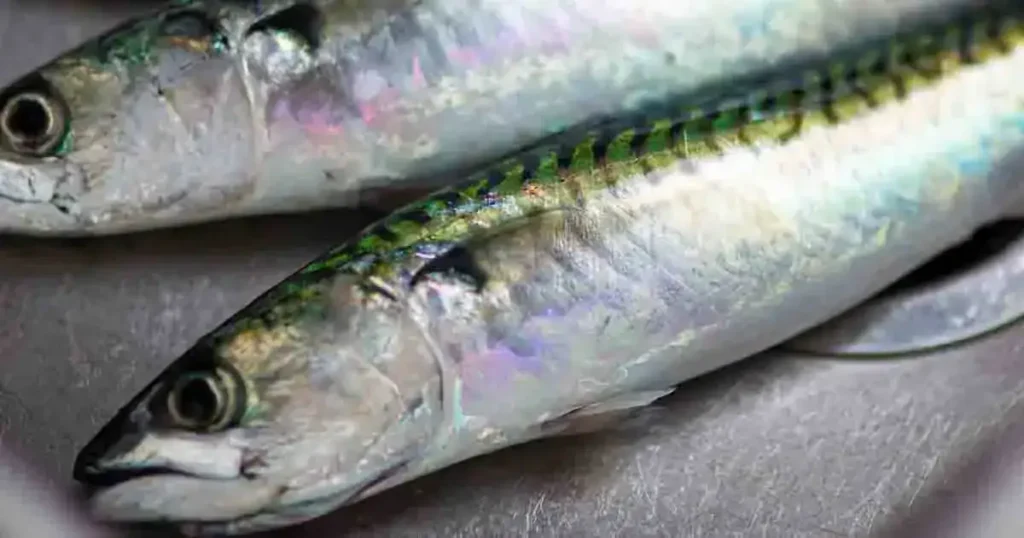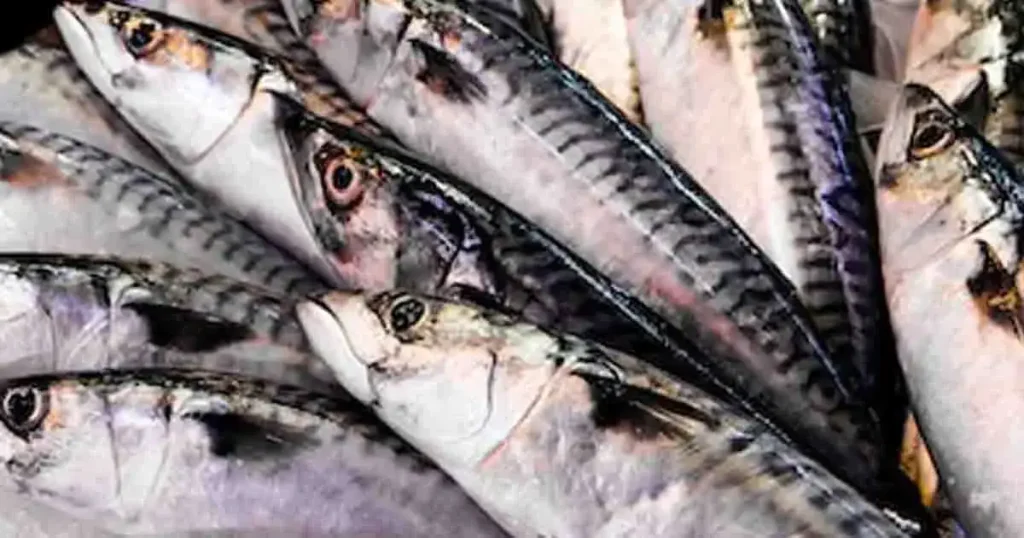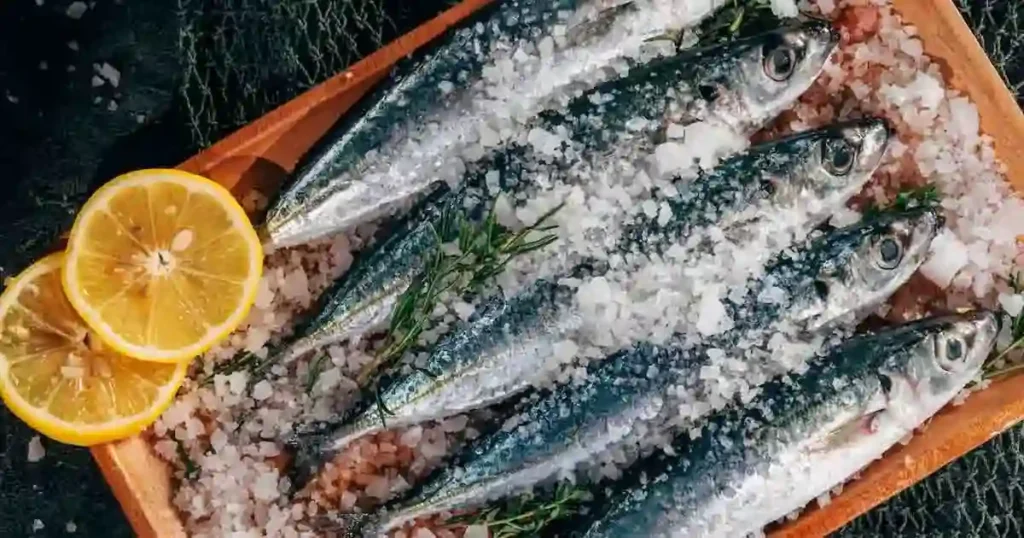The mackerel fish, scientifically known as “Scomber scombrus,” is a species of fish that holds a prominent place in the world of seafood. It is recognized for its distinct flavor, rich nutritional content, and widespread availability in various oceans and seas.
You can gather many informative points about mackerel fish from the article below. Like – Mackerel Fish in Bengali name, its cost, nutritional value, health benefits, uses, popularity, availability in the local area, and many more.

Mackerel Fish in Bengali name
Kajal Gouri or Gouri Kajal is the Bengali name for Mackerel Fish. It is a popular seafood item in Bengali cuisine, which is primarily found in the Bengali regions of India (West Bengal and parts of Bangladesh). It’s used in various dishes and preparations, contributing to the region’s rich and diverse culinary traditions.
| English name | Mackerel |
| Bengali name | Kajal Gouri or Gouri Kajal |
| Kingdom | Animalia |
| Phylum | Chordata |
| Class | Actinopterygii |
| Order | Scombriformes |
| Family | Scombridae |
| Tribe | Scombrini |
| Genus | Rastrelliger |
| Species | R. kanagurta |
Mackerel Fish is often used to prepare traditional Bengali fish curry known as “Macher Jhol.” The fish is simmered in a flavorful, aromatic gravy made with spices, tomatoes, ginger, and sometimes mustard paste. Can also be used to make fish cutlets or croquettes. The fish is mixed with mashed potatoes, spices, and herbs, then shaped into patties and fried until golden brown.
Health Benefits of Mackerel Fish
- Rich Source of Omega-3 Fatty Acids
- Heart Health
- Brain Health
- Improved Cholesterol Profile
- Anti-Inflammatory Effects
- Bone Health
- Vitamin B12
- Selenium
- Protein Content
- Weight Management
Side Effects of Mackerel Fish
While mackerel fish is generally considered a nutritious food with several health benefits, there are a some potential side effects of mackerel fish and considerations to keep in mind, particularly due to its potential mercury content and individual dietary needs. Here are some necessary points to consider:
- Mercury Content
- Allergies
- Histamine Intolerance
- Purine Content
- Interactions with Medications
- Acid Reflux
- Fish Odor
Different Varieties of Mackerel Fish
There are several different varieties of mackerel fish, each with its own characteristics, distribution, and culinary uses. Here are some of the markable varieties:
- Atlantic Mackerel (Scomber scombrus)
- Pacific Mackerel (Scomber japonicus)
- Spanish Mackerel (Scomberomorus maculatus)
- King Mackerel (Scomberomorus cavalla)
- Indian Mackerel (Rastrelliger kanagurta)
- Japanese Spanish Mackerel (Scomberomorus niphonius)
- Narrow-barred Spanish Mackerel (Scomberomorus commerson)
- Saba Mackerel (Scomberomorus niphoninus)
These are just a few examples of the many mackerel varieties found around the world. Each variety may have specific characteristics that make it suitable for different culinary preparations and regional cuisines.
Some photos of Mackerel fish


Nutritional Value of mackerel fish
Mackerel fish is known for its nutritional richness and is considered a good source of various essential nutrients. The nutritional value of mackerel can vary slightly based on the species and preparation methods, but here is an overview of the general nutritional content in a 3.5-ounce (100-gram) cooked serving of Atlantic mackerel:
| Nutritions | Values |
|---|---|
| Calories | 305 kcal |
| Protein | 20 grams |
| Total Fat | 25 grams |
| Saturated Fat | 5.7 grams |
| Monounsaturated Fat | 10.1 grams |
| Polyunsaturated Fat | 6.1 grams |
| Omega-3 Fatty Acids | 4.5 grams |
| Cholesterol | 80 milligrams |
| Sodium | 90 milligrams |
| Vitamins and Minerals | Quantity |
|---|---|
| Vitamin B12 | 16.7 micrograms |
| Selenium | 45.5 micrograms |
| Niacin | 8.9 milligrams |
| Vitamin D | 570 IU |
| Phosphorous | 280 milligrams |
| Potassium | 450 milligrams |
Farming Process of Mackerel Fish in Bengali areas
Mackerel fish are primarily wild-caught from the open ocean and are not typically farmed like some other species of fish. Mackerel are highly migratory pelagic fish that move in large schools and cover extensive distances in search of food and suitable water temperatures. This behaviour and their feeding habits make it challenging to farm in a controlled environment.
While there have been some experimental efforts to farm mackerel, they have yet to be widely successful due to these fish’s complex needs and behaviours. Unlike some other fish species that can adapt to confined aquaculture conditions, mackerel are better suited to their natural habitat in the open ocean.
Instead of traditional fish farming of mackerel fish, they are primarily harvested from the wild using fishing vessels equipped with nets or lines. These vessels target mackerel schools and use various fishing methods to catch them. The caught mackerel are then processed and distributed for consumption.
If you’re interested in fish farming, there are other species that are more amenable to aquaculture practices, such as salmon, tilapia, trout, and catfish. These fish have been successfully raised in controlled environments, allowing for more sustainable and controlled production.
Availability of Mackerel Fish in Bengali areas
Mackerel fish are widely distributed in the world’s oceans and are found in various regions, depending on the species. The availability of mackerel fish can vary based on factors such as the time of year, ocean temperatures, and migratory patterns. Here’s a general overview of the availability of mackerel fish in different regions:
- Atlantic Mackerel (Scomber scombrus) are generally found in the North Atlantic Ocean.
- Pacific Mackerel (Scomber japonicus) is generally found in the Pacific Ocean.
- Spanish Mackerel (Scomberomorus maculatus) are generally found in the western Atlantic Ocean.
- King Mackerel (Scomberomorus cavalla) are generally found in the western Atlantic and Gulf of Mexico.
- Indian Mackerel (Rastrelliger kanagurta) is generally found in the Indian Ocean and also parts of the western Pacific Ocean.
Conclusion
In conclusion, mackerel fish also known as kajal gouri in bengali are a diverse group of pelagic fish widely distributed in oceans worldwide. They belong to the family Scombridae and come in various species, each with its own characteristics and distribution.
Mackerel fish are known for their distinctive appearance, strong flavour, and high nutritional Value.
Frequently Asked Questions
1. Where can I find mackerel fish?
Mackerel fish can be found in various regions of the world’s oceans. They are often available seasonally in fish markets, grocery stores, and restaurants.
2. How do I choose fresh mackerel fish?
Look for mackerel with clear eyes, shiny skin, and a fresh ocean scent. Avoid fish with dull eyes, dry or discoloured skin, and a strong, off-putting odour.
3. What dishes can I make with mackerel fish?
Mackerel can be used in a wide range of dishes, including fish curries, stews, salads, grilled fillets, fish cakes, and pickled preparations.
4. What are some alternatives to mackerel fish?
If mackerel is not available or suitable for your dietary needs, you can consider alternatives such as salmon, sardines, herring, or other types of fatty fish rich in omega-3 fatty acids.

